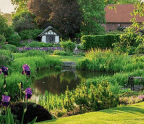

Enchanting gardens are long in the making, and Ann Bartleet’s is no exception with time-honoured trees and herculean hedges sequestering different spaces within, watched over by giant topiary snails. “It took me five years to shape the snails from yew. I did it without a frame and with only an illustration from a children’s book for a guide,” explains Ann, who had briefly considered peacocks but decided against them. “Too grand for our garden,” she notes.
Nowadays, the snails make their presence felt throughout much of the traditional country garden that Ann and her late husband, Anthony, lovingly created over the last half century at Bucklers Farmhouse near Coggeshall in Essex. Tucked away off a narrow lane and cocooned on three sides by arable fields, the two-acre garden is made up of woodland, an orchard and meadow, a Dutch-style walled garden,






